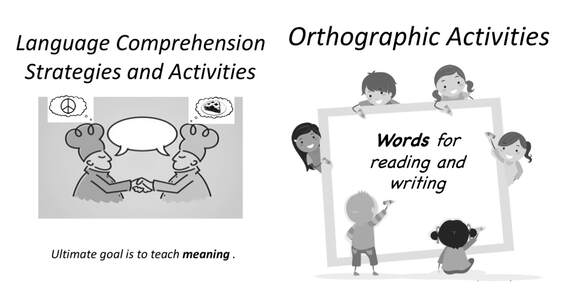|
“No single truth does not mean no truth.” - Iain McGilchrist It’s the first month of the first year of a new decade and I’m ready to tackle new blog postings. This month I’ll start with thoughts on the truths of reading instruction. In upcoming weeks and months, I’ll post activities, routines, and strategies that flow from these truths. From Research to Practice In our modern era, the definition of truth has become increasingly open to debate. Nowadays, there’s a lot of emphasis on personal truth, truth is equated with authenticity. and your truth might not be my truth. In many instances, truth, like beauty, now resides in the eye of the beholder. Historically, however, the word’s definition was rooted in objective facts, observable phenomena, and measurable standards. Because I believe teaching is the melding of art and science, I am going to use truth as defined by facts, phenomena, and agreed upon standards as my starting point. When viewed in light of reading theory and classroom instruction, Iain McGilchrist’s opening quote on truth speaks to the idea that there are many ways to teach reading and writing, and that no single way of instructing children is best. But the quote is also a reminder that no single best way does not mean no best ways at all. In fact, when it comes to helping children become competent readers, some instructional practices are better than others, and by better I mean more effective. Reading researchers know a lot about how kids learn to read and write and the theories of reading and writing processes (as well as instruction) developed by researches are increasingly stable and predictive. Here, for example, are two recent statements from well-known literacy experts. Both put a point on what others have been saying for decades:
On the one hand, statements such as these can be helpful because they point to truths about reading instruction. On the other hand, these types of statements provide little insight into what teachers can actually do in a classroom on a Monday morning. A lack of practical classroom activities built on scientific truths may be one reason the field of teaching still isn’t moving large numbers of students to the point of proficient reading (NAEP, 2017). There are other reasons, of course. Societal ills, such as drug abuse, poverty, and a weak social safety net for children, negatively impact student learning in a big way. Also, uninformed or ideological thinking among teachers and professors of education can lead to a dearth of effective instruction. A 2009 study in the Journal of Learning Disabilities found many teacher preparation programs lacked attention to concepts put forth by the National Reading Panel in 2000 . Fast forward seven years and things weren’t much better. Here’s what a 2016 Journal of Childhood & Developmental Disorders article said about one important area of reading and instruction: “Although the Science of Reading provides considerable information with regard to the nature of dyslexia, its evaluation and remediation, there is a history of ignorance, complacency and resistance in colleges of education with regard to disseminating this critical information to pre-service teachers.” One of my interests is giving teachers instructional practices, rooted in a stable theory of how reading arises in the brain, that lead to lots of learning in phonologic, orthographic, and language comprehension knowledge. These practices include teaching decoding and encoding (sometimes a lot of it) as well as metacognition and meaning (sometimes a lot of it). The parenthetical comments “sometimes a lot of it” are important because I believe reading instruction shouldn’t be balanced at all times for all kids. There are times to focus on one skill set more than another. For example, capable readers who are ready to explore genre, authors’ purpose, and metacognition strategies can be given these and for these children, pattern work and re-reading for fluency will take a back seat. Meanwhile, students still trying to “break the code,” need higher doses of encoding, decoding, and re-reading for fluency. Of course we don’t want to go overboard. Reading is always about meaning, and engaging children’s literature and comprehension activities should always have a seat at the table. The Components of Reading Success I think of effective reading instruction, grades K-2, in terms of four basic components. Because each component reinforces the other, the effect that is greater than the sum of the parts, and literacy instruction works best when all are in place.
Each of these components can be taught through any number of techniques, activities, routines, and/or strategies, which I collectively call practices. In upcoming blogs I’ll highlight ones useful for teaching low achieving readers as well as typically achieving ones, effective with young children and older children, and applicable in classroom instruction as well as specialized interventions. Also, none of the practices will be programmatic, which means they can be integrated (to varying degrees) into any number of instructional frameworks, from balanced literacy and Reader’s Workshop to basal reading programs such as Reading Street and Wonders. In my next blog, I’ll start with two ideas for building language comprehension.
Preventing Reading Difficulties When appropriate instruction and intervention are provided, most students with literacy problems in their early years do not have long-term difficulties. This is wonderful news! If we identify areas of concern early and instruct specifically and effectively, serious reading difficulties might never arise. Some research states that interventions can greatly reduce the number of children with continuing difficulties in reading, perhaps even below 2% (Torgesen, 2003; Vellutino et al., 2000). So, here’s to 2020 and to looking at instructional practices that provide foundational reading skills and help prevent reading difficulties from occurring. Thank you for joining me in the important action of teaching children to read! SOURCES
|
Mark WeaklandI am a teacher, literacy consultant, author, musician, nature lover, and life long learner.
|

 RSS Feed
RSS Feed